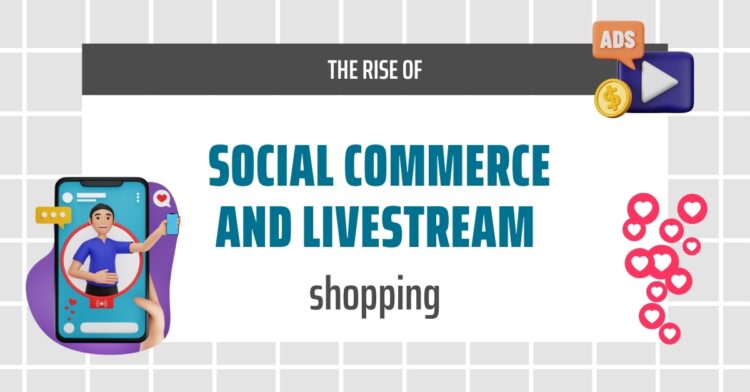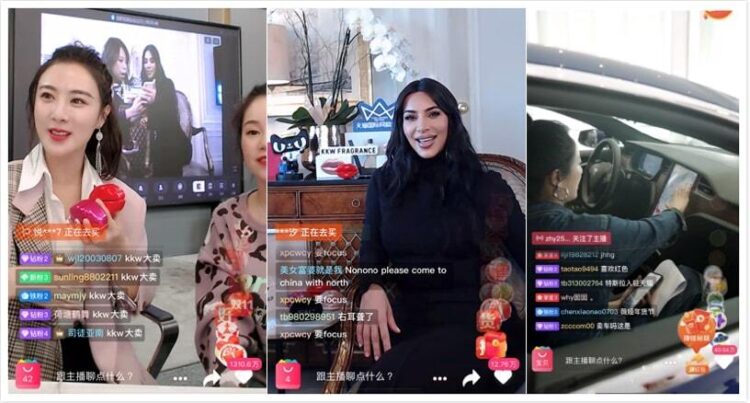The rise of social commerce and livestream shopping

In our latest blog, we dive into the revolutionary world of livestream shopping and its profound impact on small businesses. Uncover how social commerce and real-time engagement are transforming the way customers shop and interact online. Discover the allure of live streaming for Gen Z and millennial shoppers, and explore how you can leverage this dynamic trend to propel your small business to new heights.
Introduction
Once upon a time, live shopping was simply salesmen flogging their wares on QVC or other teleshopping channels only watched during unsociable hours. In recent years, the landscape of e-commerce has undergone a dramatic transformation with the emergence of social commerce and livestream shopping. These innovative trends have revolutionised the way small businesses connect with their customers, engage their audiences, and drive sales - driven especially by the boom in popularity of TikTok.
Understanding Live Streaming Social Commerce
Social commerce is the fusion of social media and e-commerce, where online shopping experiences are integrated with social platforms. It leverages the power of social networks to facilitate product discovery, enable seamless transactions, and build a sense of community among customers. Small businesses have embraced social commerce as a means to reach a wider audience, engage with potential buyers, and build brand loyalty.
This revolutionary trend has taken the digital world by storm, completely transforming the way consumers make purchasing decisions. By blending the captivating allure of livestreaming with the convenience of internet shopping, retailers have crafted an electrifying and interactive platform that captivates customers like never before. In essence, livestream social commerce revolves around presenting products and services through live video streaming, allowing for real-time interaction and sales. Imagine brands and influencers going live on popular platforms such as TikTok, Instagram, YouTube, and others tailor-made for live shopping. This convergence of live streaming, social media engagement, and seamless online transactions creates an unparalleled shopping experience that immerses consumers in a world of interactivity. In fact by 2024, e-commerce revenue from livestream shopping is expected to grow from $11 billion to $35 billion.
No longer confined to static product images or descriptions, shoppers can now engage directly with sellers, ask questions, seek advice, and witness product demonstrations in real time. The dynamic nature of livestream social commerce not only fuels excitement but also fosters a sense of trust and authenticity, crucial factors in today's fast-paced digital marketplace. In this dynamic landscape, consumers can actively participate, share their thoughts, and seek recommendations from fellow viewers. It's a shopping experience that transcends the boundaries of traditional e-commerce, creating a community-driven atmosphere that empowers buyers and strengthens their connection with brands.
As livestream social commerce continues to gain momentum, it opens up vast opportunities for retailers, influencers, and small businesses alike. Those who embrace this trend can tap into a broader audience, build lasting relationships with customers, and elevate their conversion rates to unprecedented heights.
One of the driving forces behind the success of social commerce is the rise of social media influencers. These digital personalities have amassed a substantial following and hold significant sway over their audience's purchasing decisions. Collaborating with influencers allows small businesses to tap into a ready-made customer base and establish trust and credibility.
From NFTs to the Metaverse - live stream social commerce is another digital revolution that is redefining the next stage of the internet and more specifically the online shopping experience.

The next generation of consumers
In today's ever-evolving digital landscape, influencer product recommendations and social content wield significant influence over consumers. Among these tech-savvy generations, Gen Z and millennials, live shopping is rapidly gaining popularity, offering an immersive and captivating experience that resonates with their preferences. According to Cristina Lawrence, the EVP of Consumer and Content Experience at Razorfish, Gen Z consumers are at the forefront of driving a paradigm shift in the digital realm, redefining how relationships are nurtured, purchases are made, and mobile payments are carried out.
For Gen Z, digital is an intrinsic part of their reality, and they seek out engaging and mixed-reality encounters that foster connections with the brands and communities they deeply care about. As they embrace novel ways of shopping, live shopping emerges as a compelling channel that perfectly aligns with their desire for interactive experiences.
In 2022, Statista revealed that live commerce usage was most prominent among consumers aged 18 to 34 in the United States. An impressive 10% of this age group reported using live shopping regularly. On the other hand, those aged 55 and above exhibited little to no interest in this evolving trend. When asked about preferred products for live shopping, clothing stood out as the most popular category for both male and female consumers in the U.S.
The allure of live shopping has not escaped the attention of marketers and commerce experts. Amie Owen, U.S. Head of Commerce at IPG's UM Worldwide, noted a surge in interest from clients in live shopping over the past year. The convergence of social media and retail media has created a unified platform for immersive shopping experiences. This seamless integration is poised to shape the future of commerce media, offering exciting possibilities for brands and consumers alike.
Clients are increasingly drawn to showcasing tech and beauty products through live shopping due to their intricate nature and the potential for captivating tutorial content. Infusing celebrity or creator-led livestreams with these products adds an extra layer of excitement, elevating the overall engagement with the audience.
As live shopping gains momentum, industry experts like Lundy at Publicis and Higgins emphasise that specific elements will determine its long-term success. Offering limited or exclusive products is key, providing a sense of uniqueness and urgency to viewers. The experience must be extraordinary, drawing in audiences who tune in not only to shop but to be enthralled by the captivating show.
Impact of China and emerging markets
As the trend of live livestream shopping, also known as live shopping, continues to gain momentum globally., it has already made a significant impact in China, showcasing impressive growth figures. In 2022, China's livestream e-commerce market skyrocketed, surpassing a staggering $497 billion, according to Coresight Research. The remarkable growth isn't limited to China alone, as other regions in Asia are also witnessing steady progress in their commerce landscape. While the U.S. market reached $20 billion in the same year, it pales in comparison to the explosive growth experienced in China and the rest of Asia.
According to Ashik Ashokan, the Advisory Lead of APAC at WARC, live shopping appears to have reached a more advanced stage in Asia, its birthplace, compared to the U.S. The culture surrounding live shopping in Asia seamlessly integrates "shopping and entertainment," creating a captivating and immersive experience for consumers. Conversely, live shopping in the U.S. is perceived as more "structured and straightforward," lacking the same level of interactive engagement found in Asian platforms.
Ashokan pointed out that in Asian platforms like Taobao, daily transactions amount to millions of dollars across various product categories. This robust activity demonstrates the well-established and mature nature of live shopping in Asia. On the other hand, the trend in the U.S. is still on the rise, with a stronger focus on high-end products rather than mainstream offerings, indicating its potential for further growth and development. As live shopping gains traction in the U.S., it has the potential to expand its reach and cater to a broader audience.

The benefits of livestream shopping
- Personalised Shopping Experiences: Social commerce platforms gather data on user preferences, behaviours, and interests. This data is then used to offer personalised product recommendations and targeted ads, enhancing the overall shopping experience. By tailoring their offerings to individual needs, small businesses can boost customer satisfaction and retention.
- Build Authentic Connections: Livestream shopping humanises the shopping process, allowing small businesses to engage directly with customers in real-time. The live format encourages genuine interactions, building trust and authenticity that traditional e-commerce might lack.
- FOMO and Limited-Time Offers: Fear of Missing Out (FOMO) is a powerful psychological trigger that livestream shopping leverages effectively. By offering limited-time promotions and exclusive deals during live sessions, small businesses can drive impulse purchases and create a sense of urgency among viewers.
How small businesses can tap into the new frontier
The integration of social commerce and livestream shopping has brought about several transformative impacts for small businesses:
Expanded Market Reach
With social commerce, small businesses can access global audiences, transcending geographical boundaries. Livestream shopping further widens the reach, as anyone with an internet connection can tune in, fostering an international customer base.
Enhanced Customer Engagement
Social commerce and livestream shopping encourage two-way communication between businesses and customers. This direct engagement allows businesses to understand customer preferences better, gather feedback, and tailor their offerings accordingly.
Increased Conversion Rates
The interactive nature of livestream shopping, coupled with personalised recommendations, contributes to higher conversion rates compared to traditional e-commerce. Viewers are more likely to make purchases when they feel connected to the brand and its products.
How to get started
If you're a small business owner eager to delve into the world of livestream shopping, fret not, as the process is surprisingly straightforward and immensely rewarding for connecting with your customers in real time. Below are some essential tips to get you started:
Select the Perfect Platform
With an array of platforms available for livestream shopping, it's crucial to pick one that aligns seamlessly with your business objectives. For visually-oriented products or services, platforms like Instagram Live or TikTok can be an excellent choice. Alternatively, if your offerings are more technical or gaming-related, Twitch might suit your needs better.
Plan Your Show
As with any successful show, a well-planned livestream shopping event is essential. Define the format you wish to adopt, carefully curate the products or services you'll showcase, and strategize how you'll engage with your audience effectively. A captivating title and description, accompanied by eye-catching visuals such as images and videos, can elevate the allure of your stream.
Invest in the Right Equipment
Before you go live, ensure you have the necessary equipment to stream videos seamlessly. A smartphone, tablet, or webcam connected to a computer can serve as your live streaming device. Additionally, prioritise a stable internet connection and find a quiet space conducive to filming.
Consider Influencer Partnerships
Livestream shopping can benefit significantly from partnering with influencers. Collaborating with influencers offers two key advantages: tapping into their vast followings for greater exposure and leveraging their engaging and entertaining qualities to captivate your audience. This strategic partnership can exponentially boost the reach and impact of your livestream shopping endeavours.
Conclusion
Social commerce and livestream shopping have undoubtedly disrupted the traditional e-commerce landscape, offering small businesses innovative ways to thrive in the digital age. By harnessing the power of social media, influencers, real-time engagement, and personalisation, small businesses can create authentic connections with customers and drive conversion rates like never before. Embracing these trends is no longer an option but a necessity for small businesses looking to stay competitive and successful in the dynamic world of online retail.
